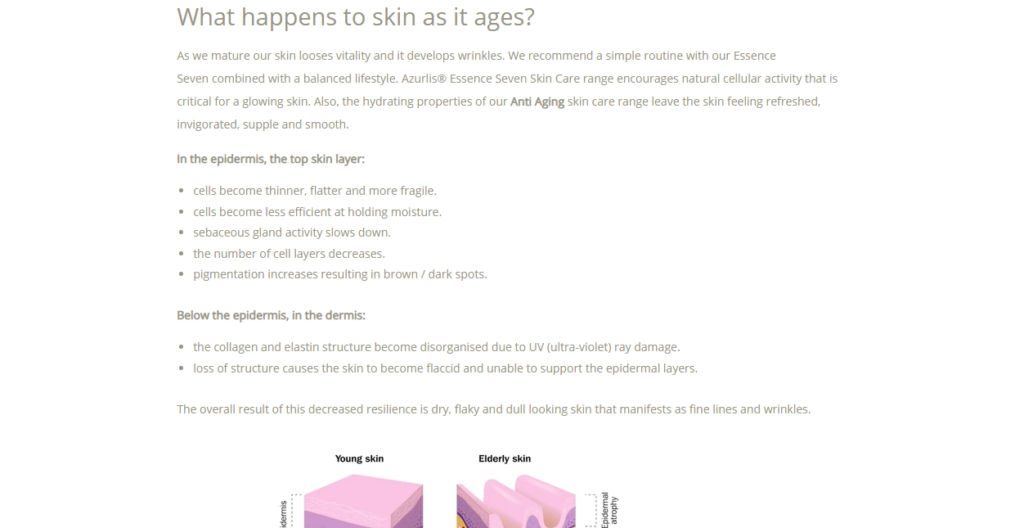Are there advantages to creating e-commerce content? And if so, what type of content will yield the best results for online retailers? Find out now!

E-commerce content can help your online store succeed
Content is king. It was true when Bill Gates said it back in 1996 and remains true (if not more relevant) today—especially if you’re a small business.
In fact, in the absence of a big budget or large marketing team, content – in all its different forms – helps online retailers in many substantial ways. Let’s take a closer look at the advantages of content marketing for e-commerce websites.
Related: How your small business benefits from blogging
Great content puts your brand on the map
The content you publish helps grow awareness of your brand where you might have otherwise remained unknown. This as people stumble upon your posts, videos and free downloads—and then go on to share them with friends and loved ones.
Remember that once those qualified prospects have consumed your content, they’re more likely to remember your name as well as what you offer.
In other words, they now know you exist and can return to your website when they’re finally ready to make a purchase.
Related: Why your brand needs to appear in users’ search results
Publishing content helps you get discovered
As a newcomer (or business with a limited marketing budget), not many people outside of your immediate circle actually know you exist. Yet you’re competing with well-known brands, large e-commerce sites and similar online stores from day one. If you’re to survive, you need to be discoverable. Useful content does just that. It helps you get found—and stand out!
This is because quality content published on a regular basis works wonders for your small business’ SEO. In fact, it can mean the difference between climbing to the top of search results and not showing up at all.
Related: How to write for customers and search engines

Content can propel prospects through their purchase journey
If you consider that consumers use search to find information or to make a purchase, it stands to reason that what you write about can actually move prospects from one stage of the buyer journey to the next. In other words your content can help readers reach a decision; convert on-the-fencers into paying customers.
Related: Why search intent is important for marketers
Here’s how that might work in real life. Let’s say you sell soap making supplies and Emma, a potential customer, wants to learn how to make homemade soap. She runs a Google search on that topic where she finds your blog post about “How to make your own all-natural soap without lye”.
The title captures her attention, so she clicks through to read your step-by-step guide. In that post, you’ve linked to the product page for your beginner’s soap making kit. Emma’s inspired by how easy it is to get started and the convenience that your kit offers so she goes ahead and places an order.
Without that blog post, Emma might have never come across your website let alone known you existed.
Quality content builds credibility in your field
Content is so powerful that it can shape the perception of a brand. And when it comes to your e-commerce success and longevity, it’s incredibly important to build trust. Well-thought-out and high quality content shows your expertise—and keeps visitors on your site!
Put another way, potential customers don’t have to leave your website to find information because you’ve already presented them with everything they need to make a decision. The longer they stay on your website, the higher the likelihood that they’re going to buy from you. Or, at the very least, remember you for later.

What kind of content do customers actually want from e-commerce businesses?
There are so many different types of e-commerce content brands can create. These range from written content like blog posts, newsletters, white papers, and social media posts to mixed media content like videos, podcasts, infographics, and webinars—just to name a few.
Related: What is evergreen content?
With all those options, it can be confusing figuring out what will work best for your brand, customers, and industry. Add to that, as marketers or small business owners, it’s easy to get caught up in our own thoughts and what we believe our readers want when the reality can often be quite different.
Take a look at what a 2018 study found:
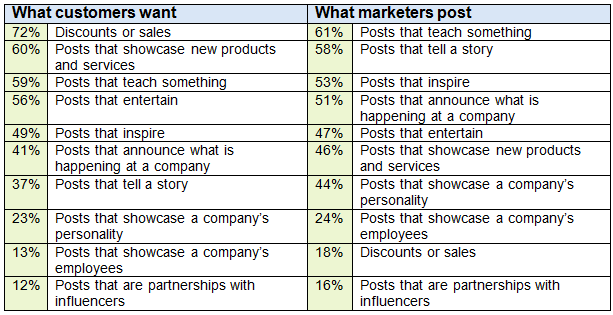
Source: sproutsocial
This information is particularly useful because it gives you a great starting point for planning your content. Well, brands obviously can’t offer sales and discounts all the time but it’s interesting to note what kind of e-commerce content customers actually want besides discounts. Namely:
- Product / service showcase
- Informative / educational posts
- Entertaining posts
- Inspiring posts
- Company happenings
There’s clearly a lot you can work with to win the hearts and minds of potential customers.
Did you know? Content writing is not copywriting! Please make sure you know the difference before you outsource your writing needs. Example: Need to create product pages or product descriptions? That should be written by a sales copywriter. Want to present a brand new product? A content writer can craft a detailed product introduction post.

Written content ideas for e-commerce businesses
If you’re reading this post, chances are you’re already convinced that content marketing has to be part of your marketing arsenal. The real question now is what should you write about?
Related: What kind of content works best for each stage of the purchase journey?
Fortunately, there’s so much going on around you to draw inspiration from. For example:
- What do your customers want to read? The previous section gives you a good idea.
- What are your competitors writing about? Find out what everyone’s talking about and build from there.
- How about your experiences? Dig deep and find compelling stories worth telling.
And that’s just the tip of the iceberg!
Here are a few other e-commerce content ideas for you to write about:
- In-depth buyer’s guides, e.g. “Top 10 pet cargo crates for air travel”
- Guides related to your product, e.g. “Useful tools for hobby home bakers”
- Tips and do-it-yourself posts, e.g. recipes, tutorials, how-to guides
- Detailed product introductions
- Product updates, changes and enhancements
- Advise on how to best use your products or alternative uses for them, e.g. “30 everyday uses for [product]”
- Inform customers about complementary products they might appreciate
- Share press coverage, partnership, and event participation updates
- Use event happenings for content
- Teach customers about your niche
- Behind-the-scenes posts
- Educate readers on various topics that matter to your brand, e.g. buying local, green initiatives, supporting local artisans
- Stories about the local community
- Announce special promotions, discounts or sales
- Interview employees, customers, and local community members
- Share user-created content, e.g. photo re-posts (with permission), compilation, stories
- News on shared interests and passions
- Create useful checklists
- Glossary of relevant terminology
- Run polls
At the end of the day, whatever e-commerce content you create, it should:
- be appreciated by your would-be customers;
- enhance your brand;
- and support your sales / marketing goals.
Learn from these AWESOME examples of e-commerce content
Need to see how others are putting those ideas into practice? Here’s what some online retailers are doing.
Put together resources to help customers achieve ONE all-important goal

The Casper Blog has put together lots of interesting but also useful content “to help you learn how to get your best night’s sleep”. Very fitting and totally on brand considering all their products are related to sleep – mattresses, pillows, bed frames and bedding.
Their content is conveniently broken down into the following categories:
- A featured article, e.g. “Sleeping Hot: Everything You Need to Know”
- Tips and advice for better sleep quality, e.g. “Latex vs Memory Foam: Which Is Better?
- Behind-the-scenes at Casper Labs, e.g. “Under the Covers with Vincent Wang, Ergonomist”
- General articles, e.g. “The Japanese Art of Lounging: The Goro Goro”
Their incredibly well-researched and well-written posts highlight their expertise and emphasise why they’re the pros when it comes to the accessories you need for good sleep. Chances are, once you’ve read their posts, you’ll want to shop their products.
Create a hub for all the tips + ideas shoppers could possibly need

Overstock.com has dedicated page that is “your everything guide to living in style”. In this one-stop-shop of useful tips and ideas, you’ll find:
- Trending (and seasonal) topics, e.g. “Autumn decorating ideas for the bedroom” and “10 stylish fall tablescapes”
- Decorating tips, e.g. “How to style a bed in 3 beautiful ways”
- Style advice and home decorating tips for every room in the house, e.g. “How to create a spa bathroom at home”
- Expert guides for outdoor living, e.g. “Patio furnishing ideas on a budget”
- Shopping tips (for holidays and every occasion), e.g. “10 thoughtful Christmas gift ideas for your wife”
- A collection of home and lifestyle expert guides as well as how-tos, e.g. “decorating with grey color schemes”
- Ideas to inspire
With all their useful (and keyword-rich) content, it’s easy for shoppers at various stages of the purchase journey to find these posts through search. From there, and since they’re already on the site, they might click onwards to the online store to learn more about some of the products mentioned in the post—and maybe even make a purchase.
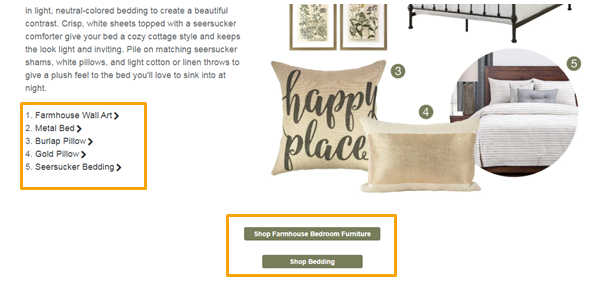
Fun content to inspire (a purchase)
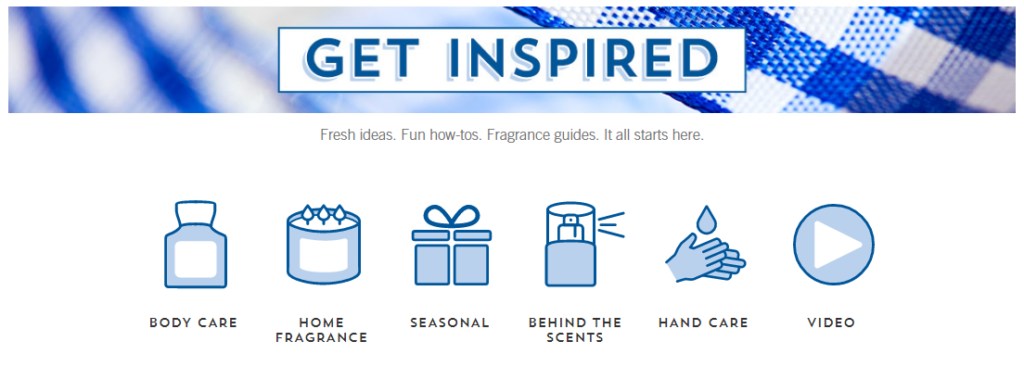
Bath and Body Works have created fun content meant to introduce new products and promote existing ones. This is in addition to timely and more serious topics like “Safe shopping guidelines” and “An update on our fight against racism and inequality”.
You’ll notice that their content complements various product categories. These include:
- Body care tips and how-tos, e.g. “Our skin care routine for your body”
- Home fragrance guides and how-tos, e.g. “The best fall candles for 2020”
- Seasonal shopping tips, guides, ideas and deals, e.g. “Sneak Peak: Black Friday 2020”
- Entertaining + practical articles related to scents, e.g. “What’s your horoscope scent?”
- Hand care tips and facts, e.g. “Hand soaps 101”
What’s also worth noting is they’ve created a comprehensive Product Ingredients resource that allows shoppers to learn more about the ingredients in all their products. It includes outbound links for regulatory information in the US and EU plus a product-specific safety data sheet that you can download.
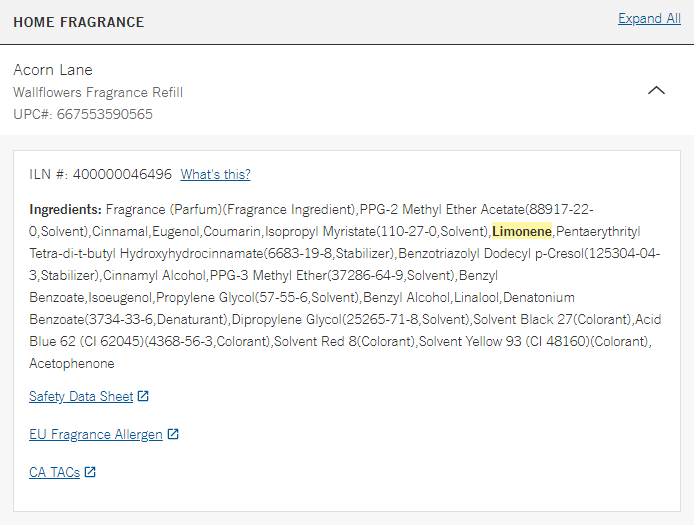
E-commerce content for different market segments
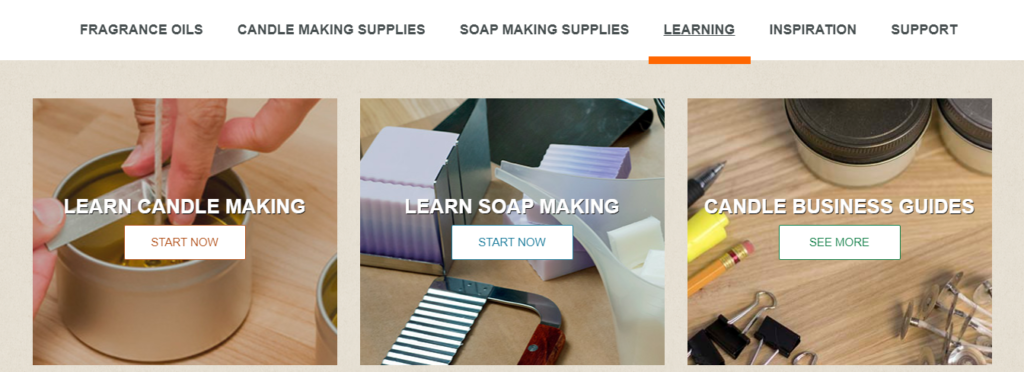
Do you serve very different customer segments? If you do, make sure you’re creating content for each one. That’s exactly what CandleScience have done with their Learning resources. There’s information suitable for hobby candle makers but also for those that want to turn their hobby into something more with candle business guide.
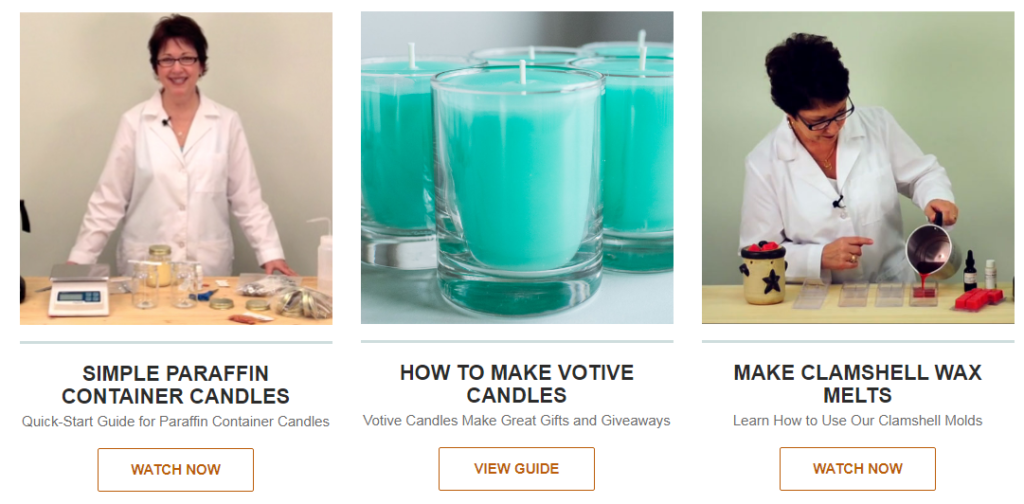
Tutorial posts conveniently link to relevant product pages, making it easy for readers to transition from research to purchase.
Content to educate—no strings attached

Sometimes, you just want to educate your readers; help them understand a specific topic and make better choices. In that case, your e-commerce content doesn’t have to link to products or nudge for the sale. It can just share genuinely useful information that your customers would appreciate. That’s precisely what Azurlis have done with their Soul & Science series of explanatory posts.
